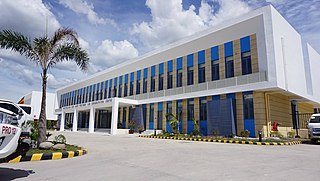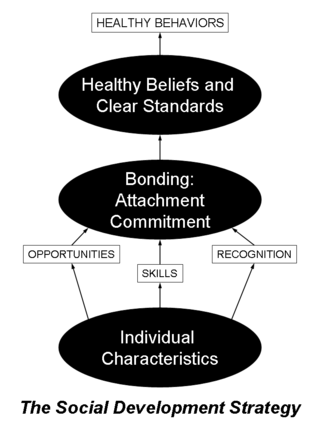Related Research Articles
Occupational therapists (OTs) are health care professionals specializing in occupational therapy and occupational science. OTs and occupational therapy assistants (OTAs) use scientific bases and a holistic perspective to promote a person's ability to fulfill their daily routines and roles. OTs have training in the physical, psychological, and social aspects of human functioning deriving from an education grounded in anatomical and physiological concepts, and psychological perspectives. They enable individuals across the lifespan by optimizing their abilities to perform activities that are meaningful to them ("occupations"). Human occupations include activities of daily living, work/vocation, play, education, leisure, rest and sleep, and social participation.

Occupational therapy (OT) is a healthcare profession that involves the use of assessment and intervention to develop, recover, or maintain the meaningful activities, or occupations, of individuals, groups, or communities. The field of OT consists of health care practitioners trained and educated to improve mental and physical performance. Occupational therapists specialize in teaching, educating, and supporting participation in any activity that occupies an individual's time. It is an independent health profession sometimes categorized as an allied health profession and consists of occupational therapists (OTs) and occupational therapy assistants (OTAs). While OTs and OTAs have different roles, they both work with people who want to improve their mental and or physical health, disabilities, injuries, or impairments.

Foster care is a system in which a minor has been placed into a ward, group home, or private home of a state-certified caregiver, referred to as a "foster parent", or with a family member approved by the state. The placement of a "foster child" is normally arranged through the government or a social service agency. The institution, group home, or foster parent is compensated for expenses unless with a family member.
School psychology is a field that applies principles from educational psychology, developmental psychology, clinical psychology, community psychology, and behavior analysis to meet the learning and behavioral health needs of children and adolescents. It is an area of applied psychology practiced by a school psychologist. They often collaborate with educators, families, school leaders, community members, and other professionals to create safe and supportive school environments.
In November 2004, voters in the U.S. state of California passed Proposition 63, the Mental Health Services Act (MHSA), which has been designed to expand and transform California's county mental health service systems. The MHSA is funded by imposing an additional one percent tax on individual, but not corporate, taxable income in excess of one million dollars. In becoming law in January 2005, the MHSA represents the latest in a Californian legislative movement, begun in the 1990s, to provide better coordinated and more comprehensive care to those with serious mental illness, particularly in underserved populations. Its claim of successes thus far, such as with the development of innovative and integrated Full Service Partnerships (FSPs), are not without detractors who highlight many problems but especially a lack of oversight, large amount of unspent funds, poor transparency, lack of engagement in some communities, and a lack of adherence to required reporting as challenges MHSA implementation must overcome to fulfill the law's widely touted potential.
In education, Response to Intervention is an approach to academic intervention used to provide early, systematic, and appropriately intensive assistance to children who are at risk for or already underperforming as compared to appropriate grade- or age-level standards. RTI seeks to promote academic success through universal screening, early intervention, frequent progress monitoring, and increasingly intensive research-based instruction or interventions for children who continue to have difficulty. RTI is a multileveled approach for aiding students that is adjusted and modified as needed if they are failing.
A mental health professional is a health care practitioner or social and human services provider who offers services for the purpose of improving an individual's mental health or to treat mental disorders. This broad category was developed as a name for community personnel who worked in the new community mental health agencies begun in the 1970s to assist individuals moving from state hospitals, to prevent admissions, and to provide support in homes, jobs, education, and community. These individuals were the forefront brigade to develop the community programs, which today may be referred to by names such as supported housing, psychiatric rehabilitation, supported or transitional employment, sheltered workshops, supported education, daily living skills, affirmative industries, dual diagnosis treatment, individual and family psychoeducation, adult day care, foster care, family services and mental health counseling.
Assertive community treatment (ACT) is an intensive and highly integrated approach for community mental health service delivery. ACT teams serve individuals who have been diagnosed with serious and persistent forms of mental illness, predominantly but not exclusively the schizophrenia spectrum disorders. ACT service recipients may also have diagnostic profiles that include features typically found in other DSM-5 categories. Many have histories of frequent psychiatric hospitalization, substance abuse, victimization and trauma, arrests and incarceration, homelessness, and additional significant challenges. The symptoms and complications of their mental illnesses have led to serious functioning difficulties in several areas of life, often including work, social relationships, residential independence, money management, and physical health and wellness. By the time they start receiving ACT services, they are likely to have experienced failure, discrimination, and stigmatization, and their hope for the future is likely to be quite low.
A group home, congregate living facility, care home, adult family home, etc., is a structured and supervised residence model that provides assisted living and medical care for those with complex health needs. Traditionally, the model has been used for children or young people who cannot live with their families or afford their own homes, people with chronic disabilities who may be adults or seniors, or people with dementia and related aged illnesses. Typically, there are no more than six residents, and there is at least one trained caregiver there 24 hours a day. In some early "model programs", a house manager, night manager, weekend activity coordinator, and four part-time skill teachers were reported. Originally, the term group home referred to homes of 8 to 16 individuals, which was a state-mandated size during deinstitutionalization. Residential nursing facilities, also included in this article, may be as large as 100 individuals in 2015, which is no longer the case in fields such as intellectual and developmental disabilities. Depending on the severity of the condition requiring one to need to live in a group home, some clients are able to attend day programs and most clients are able to live normal lifestyles.
Positive behavior support (PBS) uses tools from applied behaviour analysis and values of normalisation and social role valorisation theory to improve quality of life, usually in schools. PBS uses functional analysis to understand what maintains an individual's challenging behavior and how to support the individual to get these needs met in more appropriate way, instead of using 'challenging behaviours'. People's inappropriate behaviors are difficult to change because they are functional; they serve a purpose for them. These behaviors may be supported by reinforcement in the environment. People may inadvertently reinforce undesired behaviors by providing objects and/or attention because of the behavior.

A residential treatment center (RTC), sometimes called a rehab, is a live-in health care facility providing therapy for substance use disorders, mental illness, or other behavioral problems. Residential treatment may be considered the "last-ditch" approach to treating abnormal psychology or psychopathology.

Communities That Care (CTC) is a program of the Center for Substance Abuse Prevention (CSAP) in the office of the United States Government's Substance Abuse and Mental Health Services Administration (SAMHSA). CTC is a coalition-based prevention operating system that uses a public health approach to prevent youth problem behaviors such as violence, delinquency, school drop out and substance abuse. Using strategic consultation, training, and research-based tools, CTC is designed to help community stakeholders and decision makers understand and apply information about risk and protective factors, and programs that are proven to make a difference in promoting healthy youth development, in order to most effectively address the specific issues facing their community's youth.
An emotional or behavioral disability is a disability that impacts a person's ability to effectively recognize, interpret, control, and express fundamental emotions. The Individuals with Disabilities Education Act of 2004 characterizes the group of disabilities as Emotional Disturbance (ED). This term is controversial as it is seen by some as excluding or even discriminating against students with behavior issues and just focuses on the emotional aspects.
Multisystemic therapy (MST) is an intense, family-focused and community-based treatment program for juveniles with serious criminal offenses who are possibly abusing substances. It is also a therapy strategy to teach their families how to foster their success in recovery.
In the United States there are approximately 50 million people who are caring at home for family members including elderly parents, and spouses and children with disabilities and/or chronic illnesses. Without this home-care, most of these cared for would require permanent placement in institutions or health care facilities.
The adolescent community reinforcement approach (A-CRA) is a behavioral treatment for alcohol and other substance use disorders that helps youth, young adults, and families improve access to interpersonal and environmental reinforcers to reduce or stop substance use.
School-based prevention programs are initiatives implemented into school settings that aim to increase children's academic success and reduce high-risk problem behaviors.
Cottage homes are used in residential child care communities and other Group homes.
Residential child care communities or children's homes are a type of residential care, which refers to long-term care given to children who cannot stay in their birth family home. There are two different approaches towards residential care: The family model and the shift care model.
Trauma-informed approaches in education (TIE) are educational techniques that acknowledge the prevalence of adverse childhood experiences and other traumas on students and attempt to mitigate the widespread impact of such trauma. By adopting trauma-informed principles, educational organizations aim to create a supportive environment that facilitates learning and promotes the emotional well-being of students. Trauma-informed education is referred to with varying terminology. As articulated by the National Child Traumatic Stress Network (NCTSN), trauma-informed approaches in education aim to engage school personnel and community members in interventions that aim to identify and respond to the potential negative effects of traumatic stress within the school system.
References
- Bruns, E.J., Rast, J., Peterson, C., Walker, J., Bosworth, J. (2006). Spreadsheets, service providers, and the statehouse: Using data and the wraparound process to reform systems for children and families. American Journal of Community Psychology, 38, 201-212.
- Burchard JD, Bruns EJ, & Burchard SN (2002). The wraparound approach. In Community treatment for youth: Evidence-based interventions for severe emotional and behavioral disorders. Edited by Burns BJ, Hoagwood K. New York, Oxford University Press.
- Burns BJ & Goldman SK (Eds) (1999). Promising practices in wraparound for children with severe emotional disorders and their families. Systems of care: Promising practices in children's mental health, 1998 series: Volume IV. Washington, DC, Center for Effective Collaboration and Practice, American Institutes for Research.
- Eber, L. (2003). The Art and Science of Wraparound. Bloomington, IN: Forum on Education at Indiana University.
- Eber, L. (2005). Wraparound: Description and Case Example. In Sugai, G. & Horner, R. (2005) Ed., Encyclopedia of Behavior Modification and Cognitive Behavior Therapy: Educational Applications. 1601-1605. Thousand Oaks: Sage.
- Eber, L., Nelson, C.M., & Miles, P. (1997). School-based wraparound for students with emotional and behavioral challenges. Exceptional Children, 63(4), 539-555.
- Kamradt, B. (2000). Wraparound Milwaukee: Aiding youth with mental health needs. Juvenile Justice 7, 14-23.
- Kendziora K, Bruns E, Osher D, et al. (Eds) (2001). Wraparound: Stories from the field. Systems of care: Promising practices in children's mental health, 2001 series: Volume I. Washington, DC, Center for Effective Collaboration and Practice, American Institutes for Research.
- Walker, J.S. & Bruns, E.J. (2006). Building on practice-based evidence: Using expert perspectives to define the wraparound process. Psychiatric Services, 57(11), 1579-1585.
- Walker JS, Koroloff N, & Schutte K (2003). Implementing high-quality collaborative Individualized Service/Support Planning: Necessary conditions, Portland OR: Research and Training Center on Family Support and Children's Mental Health.
Extra References for Review of Outcomes Studies
- Bickman, L., Smith, C., Lambert, E. W., & Andrade, A. R. (2003). Evaluation of a congressionally mandated wraparound demonstration. Journal of Child & Family Studies, 12, 135-156.
- Carney, M. M., & Buttell, F. (2003). Reducing juvenile recidivism: Evaluating the wraparound services model. Research on Social Work Practice, 13, 551-568.
- Clark, H.B., Lee, B., Prange, M.E. & McDonald, B.A. (1996).Children lost within the foster care system: Can wraparound service strategies improve placement outcomes? Journal of Child and Family Studies, 5, 39-54.
- Clark, H. B., Prange, M. E., Lee, B., Stewart, E. S., McDonald, B. B., & Boyd, L. A. (1998). An individualized wraparound process for children in foster care with emotional/behavioral disturbances: Follow-up findings and implications from a controlled study. In M. H. Epstein, K. Kutash & A. Duchnowski (Eds.), Outcomes for children and youth with emotional and behavioral disorders and their families: Programs and evaluation best practices (pp. 513-542). Austin, TX: Pro-ED, Inc.
- Evans, M.E., Armstrong, M.I., Kuppinger, A.D. (1996). Family-Centered Intensive Case Management: A Step Toward Understanding Individualized Care. Journal of Child and Family Studies, 5, 55-65.
- Evans, M. E., Armstrong, M. I., Kuppinger, A. D., Huz, S., & McNulty, T. L. (1998). Preliminary outcomes of an experimental study comparing treatment foster care and family-centered intensive case management. In Epstein, M.H. (Ed); Kutash, K (Ed); et al. (1998). Outcomes for children and youth with emotional and behavioral disorders and their families: Programs and evaluation best practices. (pp. 543–580). Xviii, 738 pp.
- Hyde, K. L., Burchard, J. D., & Woodworth, K. (1996). Wrapping services in an urban setting. Journal of Child & Family Studies, 5(1), 67-82.
- Myaard, M. J., Crawford, C., Jackson, M., & Alessi, G. (2000). Applying behavior analysis within the wraparound process: A multiple baseline study. Journal of Emotional & Behavioral Disorders, 8, 216-229.
- Pullmann, M. D., Kerbs, J., Koroloff, N., Veach-White, E., Gaylor, R., & Sieler, D. (2006). Juvenile offenders with mental health needs: Reducing recidivism using wraparound. Crime and Delinquency, 52, 375-397.
- Rast, J., Bruns, E.J., Brown, E.C., Peterson, C.R., & Mears, S.L. (submitted May 2007). Impact of the wraparound process in a child welfare system: Results of a matched comparison study. Social Work Research.